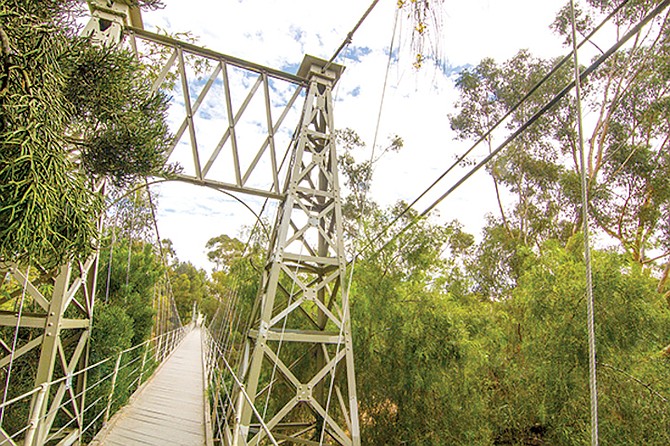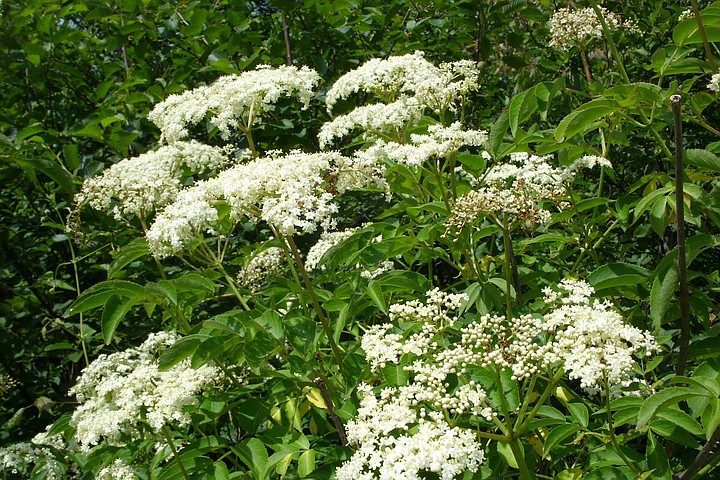 Facebook
Facebook
 X
X
 Instagram
Instagram
 TikTok
TikTok
 Youtube
Youtube

Ocean Water Temperatures are rising into the mid-60s this month, perhaps to reach the low 70s in August. The usual early-summer cool weather along San Diego's coastline, disappointing to many tourists, is mostly caused by the sluggish warming of the ocean water. The payoff will come later: as the ocean gives up heat absorbed during the sunny summer months, we'll enjoy warm days and evenings well into autumn.
Spring Wildflowers may have largely dried up in most areas of San Diego County, but in the cooler coastal enclaves such as Cabrillo National Monument and Torrey Pines State Reserve, several kinds remain. Look for paintbrush, purple nightshade, coreopsis, sea fig, popcorn flower, and red monkey flower, among others.

Elderberry, two species of which range over most of San Diego County, is in full bloom this month. The flat-topped, creamy white blossoms of this large shrub or small tree can be seen in the natural coastal canyon areas such as Tecolote Canyon and Los Penasquitos Canyon Preserve, as well as in the more moist areas of the foothills and mountains. The elderberry's tiny fruits, which ripen in late summer, have traditionally been used for various drinks and preserves.
The Chirping of Crickets tells us the warmer weather of summer is well on its way. Their plaintive pleadings for mates are heard wherever bits of semi-natural scenery cut across the urban tapestry of San Diego. Try the Spruce Street suspension footbridge, just west of Balboa Park between Front and Brant Streets. From the swaying bed of the 70-foot-high bridge you can admire a canyon filled with green and gold grasses, nasturtiums, and eucalyptus, pepper, and palm trees. Sound effects begin by mid-afternoon.
Bright Venus and the thin crescent Moon form a mystic pair low in the west-northwest in twilight, Friday, June 11. They'll be 3° or 4° apart for skywatchers near the US East Coast, and only 2° by the time of twilight for the West Coast. Your best view might be about 40 or 50 minutes after sunset, before they get too low.
The Big Dipper hangs high in the northwest right after dark, Saturday, June 12. The Dipper's Pointers, currently its bottom two stars, point lower right toward Polaris. Above Polaris, and looking very similar to it, is Kochab, the lip of the Little Dipper's bowl.
The above comes from the Outdoors listings in the Reader compiled by Jerry Schad, author of Afoot & Afield in San Diego County. Schad died in 2011. Planet information from SkyandTelescope.org.


Ocean Water Temperatures are rising into the mid-60s this month, perhaps to reach the low 70s in August. The usual early-summer cool weather along San Diego's coastline, disappointing to many tourists, is mostly caused by the sluggish warming of the ocean water. The payoff will come later: as the ocean gives up heat absorbed during the sunny summer months, we'll enjoy warm days and evenings well into autumn.
Spring Wildflowers may have largely dried up in most areas of San Diego County, but in the cooler coastal enclaves such as Cabrillo National Monument and Torrey Pines State Reserve, several kinds remain. Look for paintbrush, purple nightshade, coreopsis, sea fig, popcorn flower, and red monkey flower, among others.

Elderberry, two species of which range over most of San Diego County, is in full bloom this month. The flat-topped, creamy white blossoms of this large shrub or small tree can be seen in the natural coastal canyon areas such as Tecolote Canyon and Los Penasquitos Canyon Preserve, as well as in the more moist areas of the foothills and mountains. The elderberry's tiny fruits, which ripen in late summer, have traditionally been used for various drinks and preserves.
The Chirping of Crickets tells us the warmer weather of summer is well on its way. Their plaintive pleadings for mates are heard wherever bits of semi-natural scenery cut across the urban tapestry of San Diego. Try the Spruce Street suspension footbridge, just west of Balboa Park between Front and Brant Streets. From the swaying bed of the 70-foot-high bridge you can admire a canyon filled with green and gold grasses, nasturtiums, and eucalyptus, pepper, and palm trees. Sound effects begin by mid-afternoon.
Bright Venus and the thin crescent Moon form a mystic pair low in the west-northwest in twilight, Friday, June 11. They'll be 3° or 4° apart for skywatchers near the US East Coast, and only 2° by the time of twilight for the West Coast. Your best view might be about 40 or 50 minutes after sunset, before they get too low.
The Big Dipper hangs high in the northwest right after dark, Saturday, June 12. The Dipper's Pointers, currently its bottom two stars, point lower right toward Polaris. Above Polaris, and looking very similar to it, is Kochab, the lip of the Little Dipper's bowl.
The above comes from the Outdoors listings in the Reader compiled by Jerry Schad, author of Afoot & Afield in San Diego County. Schad died in 2011. Planet information from SkyandTelescope.org.
Comments